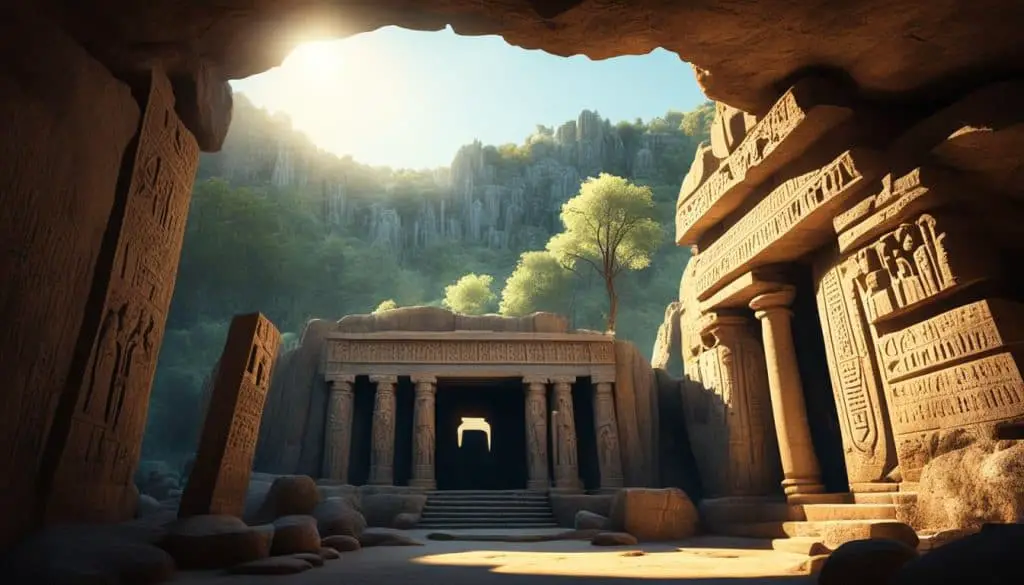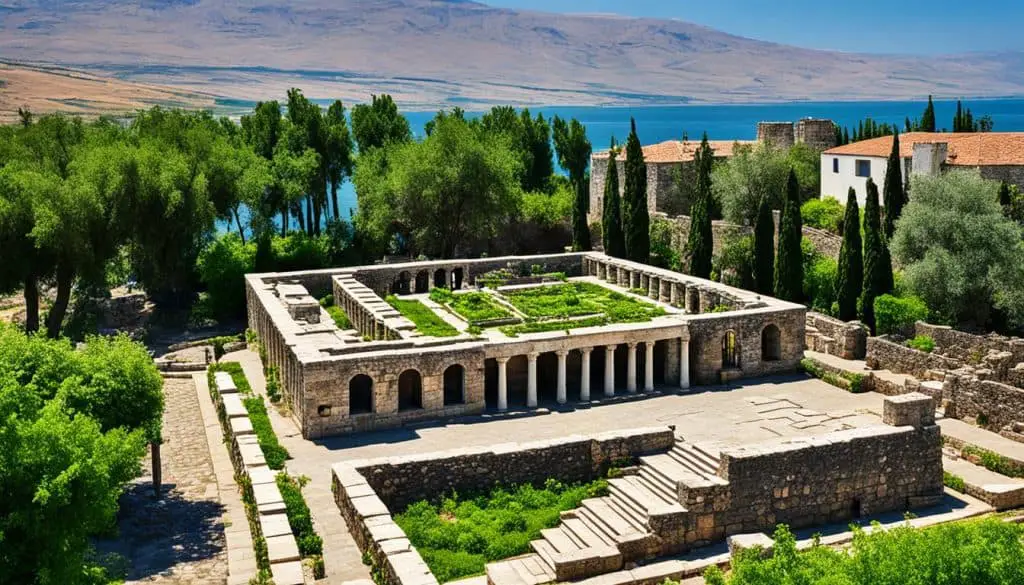Table of Contents
In this article, we will delve into the mysteries of the past and explore five Biblical buildings that have defied the ravages of time. These remarkable structures stand as testaments to miraculous preservation, captivating our imagination and offering glimpses into ancient tales that continue to resonate today. From walls that crumbled to tombs that held the promise of eternity, these sites hold secrets waiting to be discovered.
But here’s a question that lingers: How can these ancient buildings withstand the test of time while countless others have succumbed to decay? Is there something more than mere chance at play? Join us as we uncover the astonishing stories and delve into the awe-inspiring realm of these miraculously preserved Biblical buildings.
The Walls of Jericho – The City That Came Tumbling Down… But Not All of It!
The story of the walls of Jericho is a well-known tale of triumph. Despite their perceived impenetrability, the walls came crashing down when the good guys, armed with faith and trumpet blasts, conquered the city. Surprisingly, researchers have uncovered evidence of these walls, providing a tangible connection to this ancient city. It’s as if we are peering into a storybook come to life.
“And the walls came tumbling down…”
In the account found in the Book of Joshua, the walls of Jericho were said to have miraculously crumbled after seven days of circling the city and sounding trumpets. This event was a crucial victory for the ancient Israelites, paving the way for the conquest of the Promised Land.
Archaeologists and historians have dedicated countless hours to unraveling the secrets of Jericho, seeking to authenticate the biblical narrative. Their efforts have yielded fascinating discoveries, including remnants of the city walls and evidence of destruction.
The Walls of Jericho have become more than just a biblical account; they have captured the imagination of many, inspiring books, songs, and works of art. The archaeological findings provide a tangible link to the events described in ancient texts, reinforcing the belief that history and faith can intertwine.
Uncovering Jericho’s Walls: A Rediscovery of Faith
Over the years, several archaeological excavations have taken place at the site of ancient Jericho, shedding light on the city’s past. These findings have not only fascinated scholars but also offered a glimpse into the ancient world for visitors from around the globe.
“The remarkable discoveries at Jericho continue to captivate both believers and skeptics, revealing that the walls that crumbled so long ago are not just a relic of faith but a testament to the enduring power of history.”
The remnants of the walls found at Jericho are a compelling testament to the events described in the biblical account. They stand as a physical reminder of a miraculous victory, encouraging us to reflect on the power of faith and the triumph of the human spirit.
- The walls of Jericho represented a formidable obstacle for the Israelites.
- Joshua’s faith and obedience led to the walls’ collapse, defying all natural laws.
- Archaeological excavations have provided evidence of the ancient city walls, affirming the historical authenticity of the biblical narrative.
- Visiting the site of ancient Jericho allows us to connect with the stories of old, sparking contemplation and awe.
As we explore the remains of the Walls of Jericho, we are reminded of the extraordinary tales that shaped our collective history. They serve as a testament to the intersection of faith and archaeology, inviting us to witness the tangible echoes of a long-past event.
The Tomb of Jesus – The Empty Cave That Changed History
The tomb of Jesus is a place of profound significance in the Christian faith. It is believed to be the resting place of Jesus, marking a pivotal moment in history. Today, this empty cave remains as a silent witness to the resurrection story that has resonated around the world for millennia.
Visiting the tomb of Jesus offers a unique opportunity to connect with the roots of Christianity. As you step into this sacred site, you can’t help but feel a sense of awe and wonder. The atmosphere is filled with reverence and contemplation, as you consider the profound impact of this empty tomb.

“He is not here; he has risen!” – Matthew 28:6
As you explore the tomb, you can’t help but reflect on the historical events that unfolded within its walls. It was here that Jesus was laid to rest after his crucifixion, and it was from here that he miraculously rose from the dead. This empty cave serves as a powerful testament to the resurrection, inspiring hope and faith in the hearts of believers.
Throughout the centuries, pilgrims from all over the world have made their way to the tomb of Jesus, seeking solace and spiritual connection. The experience of standing in this holy place is both humbling and transformative, as you become part of a lineage of believers who have been touched by the story of Jesus.
The Significance of the Empty Tomb
The empty tomb of Jesus holds deep significance for Christians worldwide. It symbolizes victory over death, the triumph of hope, and the promise of eternal life. It is a reminder that even in the face of darkness and despair, there is always the possibility of renewal and transformation.
The empty tomb serves as a testament to the power of faith and the enduring impact of Jesus’ life and teachings. It stands as a beacon of hope, inviting believers to embrace the message of love, forgiveness, and redemption that lies at the heart of the Christian faith.
Visiting the Tomb of Jesus
Today, the tomb of Jesus is a revered pilgrimage site for Christians around the world. Located in the Church of the Holy Sepulchre in Jerusalem’s Old City, the tomb offers a sacred space for prayer, reflection, and worship.
When visiting the tomb, it is essential to approach with respect and reverence. The site is considered holy ground, and it is customary to be mindful of others, maintain a spirit of solemnity, and adhere to any guidelines or restrictions set by the church.
Experience the profound significance of the empty tomb and witness the enduring impact of Jesus’ resurrection at the tomb of Jesus in the Church of the Holy Sepulchre.
| Visiting Information | Location | Opening Hours | Admission Fee |
|---|---|---|---|
| Church of the Holy Sepulchre | Jerusalem, Israel | Monday-Saturday: 8:00 AM – 6:00 PM Sunday: 7:00 AM – 6:00 PM |
Free |
Solomon’s Temple – The Lost Treasure of a Mighty Kingdom
King Solomon’s Temple stands as a testament to the opulence and grandeur of a bygone era. This awe-inspiring structure, once the focal point of a mighty kingdom, captivated all who gazed upon its splendor. Although the temple itself has long been lost to time, the legacy of its magnificence lives on through countless stories and descriptions that continue to enchant and inspire.
As you delve into the history of Solomon’s Temple, you can’t help but be transported to a world of architectural wonders and divine reverence. The scriptures paint a vivid picture of a structure adorned with exquisite craftsmanship and lavish materials. Gold, silver, cedar, and precious stones were meticulously incorporated into the temple’s design, leaving observers in awe of its unmatched beauty.
However, the true majesty of Solomon’s Temple was not confined to its physical attributes alone. This sacred place served as a spiritual hub, a connection between heaven and earth. It was a sanctuary where the divine presence dwelled, attracting pilgrims from far and wide who sought solace, guidance, and a deepening of faith.
Interestingly, the temple’s architectural and spiritual significance extended beyond the borders of ancient Israel. Scholars and historians of various backgrounds have devoted their lives to unraveling the secrets of this marvel. Through meticulous research and excavations of ancient sites, they have pieced together a detailed understanding of Solomon’s Temple, reinforcing its status as a legendary feat of human ingenuity and devotion.
“The temple was unlike any other structure of its time, both in terms of its sheer grandeur and the profound sense of holiness that permeated its every corner. It was a place where the divine touched the earthly realm, and its loss remains a tragic reminder of the impermanence of all things.”
The Glory and Destruction
The splendor of Solomon’s Temple was short-lived, as it fell victim to the ravages of war and conquest. The Babylonians, under the leadership of King Nebuchadnezzar, laid siege to Jerusalem and ruthlessly destroyed the temple in 586 BCE. The loss was devastating, leading to a period of exile and despair for the Israelites.
Yet, despite the temple’s destruction, its memory endured. The accounts of its magnificence were passed down through generations, further fueling the desire to rebuild and restore what had been lost.
A Glimpse Into the Past
Today, while the physical structure of Solomon’s Temple cannot be visited, archaeological excavations and historical records offer us a tantalizing glimpse into its past. The artifacts and remnants discovered serve as a powerful testament to the grandeur and significance of this once-mighty edifice.
| Features | Description |
|---|---|
| Pillars of Boaz and Jachin | The pillars that stood at the entrance of the temple, symbolizing strength, stability, and divine blessings. |
| Cherubim | Intricately crafted, winged angelic figures that adorned the innermost sanctuary of the temple, representing wisdom, protection, and the divine presence. |
| Ark of the Covenant | A sacred chest that held the tablets of the Ten Commandments, serving as a visible reminder of God’s covenant with His people. |
These archaeological findings, combined with the enduring spiritual significance of Solomon’s Temple, continue to captivate the imaginations of believers and scholars alike. The legacy of this lost treasure serves as a reminder of the fleeting nature of material wealth and the enduring power of faith.
The House of Peter in Capernaum – Where Miracles Happened
In the small fishing village of Capernaum, a humble house served as a base for miracles attributed to Jesus and witnessed by Peter. Today, archaeologists have unearthed what they believe to be this very house, buried beneath layers of history. It now stands as a place of pilgrimage and wonder, embodying the stories of healing and teaching that took place within its walls.
Capernaum, located on the northern shore of the Sea of Galilee, was a significant location in Jesus’ ministry. As one of his preferred places to teach and perform miracles, it holds a special place in Christian history. And at the heart of it all is the House of Peter, where Jesus and his disciples often gathered.
“And immediately he entered the house of Simon and Andrew, with James and John. Now Simon’s mother-in-law lay ill with a fever, and immediately they told him about her. And he came and took her by the hand and lifted her up, and the fever left her, and she began to serve them.” Mark 1:29-31 (ESV)
According to historical records and archaeological evidence, the House of Peter was a simple dwelling made of basalt stones, similar to surrounding structures in Capernaum. The interior consisted of several rooms, including a central area for gatherings and a courtyard.
Throughout Jesus’ time in Capernaum, various miracles took place within the walls of this unassuming house. People sought healing and blessings, and Peter, being a witness to these incredible events, must have been profoundly impacted by what he experienced.

Today, visitors to Capernaum can explore the archaeological site that is believed to be the House of Peter. Standing among the ruins, you can imagine the teachings, healings, and moments of divine encounter that occurred here. The site offers a unique opportunity to connect with the miracles and teachings of Jesus in a tangible way.
The House of Peter in Capernaum stands as a reminder of the transformative power of faith and the extraordinary events that took place during Jesus’ ministry. It invites visitors to reflect on the miracles that unfolded within its walls and to contemplate the significance of these experiences in their own lives.
Are the Biblical Buildings That Were Miraculously Preserved Related to the Major Fortifications of Ancient Israel?
The biblical buildings that were miraculously preserved bear a significant connection to the major fortifications of ancient Israel. These structures offer a fascinating glimpse into the military strategy and architectural prowess of the ancient Israelites. Exploring these ancient Israel fortifications guide us in understanding the rich history of the region.
The Pool of Bethesda – The Site of an Impossible Healing
The Pool of Bethesda carries with it a tale of a man healed against all odds. This iconic site in Jerusalem was a gathering place for people hoping for a miracle. According to the stories, one fortunate individual experienced a miraculous healing after enduring decades of suffering. Today, you have the opportunity to visit the remains of what is believed to be this sacred pool and immerse yourself in the peaceful atmosphere that serves as a reminder of the profound power of hope and faith.
Stepping into the presence of the Pool of Bethesda transports you back to a time when the line between the ordinary and the extraordinary blurred. The air is thick with the echoes of desperate prayers and the longing for a divine touch. As you explore the ancient ruins, you can’t help but imagine the scene’s ethereal ambiance, where the possibility of a life-altering encounter lingered in the air.
The Pool of Bethesda’s significance stretches beyond the physical realm. It stands as a testament to the unwavering human spirit, a tribute to the strength of belief when all seems impossible. It serves as a reminder that even in the face of seemingly insurmountable challenges, there is a glimmer of hope, a chance for a miracle. Visiting this hallowed site allows you to tap into the profound sense of possibility that exists within each and every one of us.






